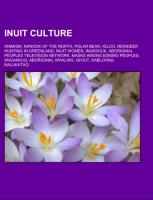- Start
- Inuit culture
Inuit culture
Angebote / Angebote:
Source: Wikipedia. Pages: 56. Chapters: Animism, Nanook of the North, Polar bear, Igloo, Reindeer hunting in Greenland, Inuit women, Inukshuk, Aboriginal Peoples Television Network, Masks among Eskimo peoples, Angakkuq, Aboriginal whaling, Qiviut, Kabloona, Nalukataq, Inuit Qaujimajatuqangit, The Savage Innocents, St. Jude's Cathedral, Pisissarfik, The Necessities of Life, Eskimo kinship, Disc number, Eskimo kissing, Inu-Yupiaq, National Aboriginal Day, Inuktitut, Artcirq, Siqqitiq, Inuksuk Point, Inuit Broadcasting Corporation, Inuit astronomy, Inuit weapons, Pittailiniit, Peary-MacMillan Arctic Museum, Burial tree. Excerpt: The polar bear (Ursus maritimus) is a bear native largely within the Arctic Circle encompassing the Arctic Ocean, its surrounding seas and surrounding land masses. It is the world's largest land carnivore and also the largest bear, together with the omnivorous Kodiak Bear, which is approximately the same size. An adult male weighs around 350-680 kg (770-1, 500 lb), while an adult female is about half that size. Although it is closely related to the brown bear, it has evolved to occupy a narrower ecological niche, with many body characteristics adapted for cold temperatures, for moving across snow, ice, and open water, and for hunting the seals which make up most of its diet. Although most polar bears are born on land, they spend most of their time at sea. Their scientific name means "maritime bear", and derives from this fact. Polar bears can hunt their preferred food of seals from the edge of sea ice, often living off fat reserves when no sea ice is present. The polar bear is classified as a vulnerable species, with eight of the 19 polar bear subpopulations in decline. For decades, large scale hunting raised international concern for the future of the species but populations rebounded after controls and quotas began to take effect. For thousands of years, the polar bear has been a key figure in the material, spiritual, and cultural life of Arctic indigenous peoples, and polar bears remains important in their cultures. Constantine John Phipps was the first to describe the polar bear as a distinct species in 1774. He chose the scientific name Ursus maritimus, the Latin for 'maritime bear', due to the animal's native habitat. The Inuit refer to the animal as nanook (transliterated as nanuq in the Inupiat language). The Yupik also refer to the bear as nanuuk in Siberian Yupik. The bear is umka in the Chukchi language. In Russian, it is usually called ¿¿¿¿¿¿ ¿¿¿¿¿¿¿¿ (bélyj medvédj, the white bear), though an older word still in use is ¿¿¿¿¿¿ (Oshkúj, which comes from th
Folgt in ca. 5 Arbeitstagen
